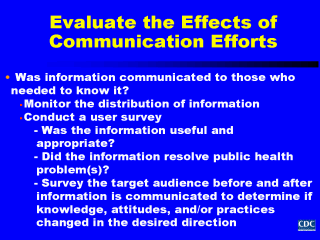| front |1 |2 |3 |4 |5 |6 |7 |8 |9 |10 |11 |12 |13 |14 |15 |16 |17 |18 |19 |20 |21 |22 |23 |24 |25 |26 |27 |28 |review |
 |
Finally, once we have provided feedback, we should evaluate the effects of our communication efforts. Was the information provided to those who needed to know? We can determine the answer to this question by monitoring the distribution of the information. For example, the effectiveness of communication provided through newspapers can be evaluated by using clipping services who determine the number of published reports, their geographic distribution, and review the content of articles to assess their accuracy. Surveys of individuals or groups targeted for the feedback information can also be conducted to determine if the information was useful and appropriate to their needs. We can also ask if the information shared had a beneficial effect on the public health problems or conditions of interest, i.e., the impact of the communication effort on changing the knowledge, attitudes, and/or practices within specific target audiences. This is accomplished by surveying our target audiences before and after surveillance information is shared to see if any changes have occurred. |
| front |1 |2 |3 |4 |5 |6 |7 |8 |9 |10 |11 |12 |13 |14 |15 |16 |17 |18 |19 |20 |21 |22 |23 |24 |25 |26 |27 |28 |review |